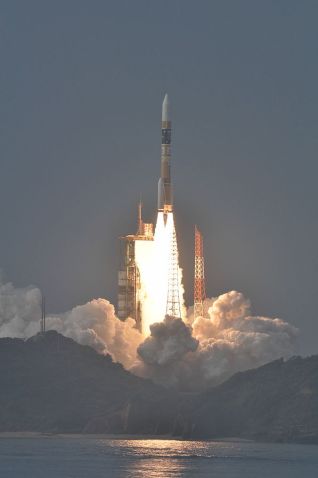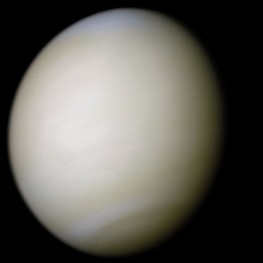This an update to my original post from 4 December.
In a press release today the Japanese space agency JAXA confirmed that the smaller rocket motors had fired as planned and the Akatsuki is now in orbit round Venus. The announcement (http://global.jaxa.jp/press/2015/12/20151207_akatsuki.html) went on to say:
“The orbiter is now in good health. We are currently measuring and calculating its orbit after the operation. It will take a few days to estimate the orbit, thus we will announce the operation result once it is determined.”
This is great achievement for the Japanese space programme and hopefully the spacecraft will provide us with many exciting discoveries about Venus.

The image shown above was taken by Akatsuki in ultraviolet light on 7 December 2015, just after it went into orbit around Venus. It shows far more detail of the cloud patterns in the planet’s upper atomosphere than can be seen in visible light.
Original post below
On 7 December 2010 the Japanese spacecraft Akatsuki (named after the Japanese word for dawn) arrived at Venus after a six month journey. It was only the second spacecraft launched since 1989 to visit the Earth’s sister planet and, if it had succeeded in orbiting Venus, it would have had been a tremendous boost for the Japanese space programme.
Launch of Akatsuki in May 2010 – Image from Wikimedia Commons
Unfortunately, when it arrived at Venus its main engine failed to fire properly to slow the spacecraft down and put it into orbit, so it shot past the planet and went into orbit around the Sun.
Venus as seen from Earth – Image from NASA
However all was not lost. Other than the main engines, all parts of the spacecraft turned out to be fully functioning, and the Japan Aerospace Exploration Agency (JAXA) will get a second chance to get Akatsuki into orbit when it passes close to Venus on Monday 7 December. This is very unusual for spacecraft which fail to go into orbit. Normally when a major mishap like this occurs the space agency doesn’t get a second chance.
How will the spacecraft get into orbit if its main engine has failed?
The thrust or force provided by rocket motors is usually measured in units called newtons, usually abbreviated to N. The main engine which failed to fire had a thrust of 500 N. To get the spacecraft into orbit JAXA will need to fire 4 of the 8 small rocket motors which were only designed to finely tune the spacecraft’s position. Each of these small motors only generates 20 N thrust and they will have to fire for a total of nearly 21 minutes to slow down the spacecraft to allow it go into orbit, something they were never designed to do. It is also fortunate that, unlike most spacecraft, the small rocket motors and the faulty main engine of the spacecraft use the same fuel, a liquid called hydrazine. If this was’t the case then this rescue operation would be impossible.
What will the spacecraft achieve?
Assuming the spacecraft successfully gets into orbit around Venus it has a whole host of instruments which will return useful data. Some of these are listed below:
- a special camera to study lightning flashes, which it will do when on the night side of Venus
- an instrument to study the structure of high-altitude clouds to enable us to understand more about Venus’s weather
- an ultraviolet camera to study the distribution of specific atmospheric gases such as sulfur dioxide in ultraviolet light, a form of light invisible to the naked eye
- an infrared defector which will peer through Venus’s atmosphere to see heat radiation emitted from Venus’ surface rocks and will help researchers to spot active volcanoes, if they exist.
Let’s all keep our fingers crossed for a success on December 7!
Artists impression of Akatsuki orbiting Venus – Image from JAXA





[…] Akatsuki – a second chance describes the mission of the Japanese spacecraft Akatsuki which is currently in orbit around Venus studying its weather. The spacecraft should have gone into orbit in 2010. This didn’t happen but mission control were able to successfully put the spacecraft in hibernation for 5 years before making another successful attempt. […]
LikeLike
[…] Akatsuki a second chance describes the mission of the Japanese spacecraft Akatsuki which is currently in orbit around Venus studying its weather. The spacecraft should have gone into orbit in 2010. This didn’t happen but mission control were able to successfully put the spacecraft in hibernation for 5 years before making another successful attempt. […]
LikeLike
[…] shortly after it went into orbit around Venus last month. For the full story on this spacecraft click here. In what is known as ‘visible light’ (see below), Venus is a fairly featureless […]
LikeLike
Woo hoo!!!
http://www.cnet.com/news/japans-akatsuki-orbiter-sends-back-triumphant-venus-images/
LikeLike
Go Akatsuki!!! 😀
LikeLike
Looking forward to some great science from JAXA and Akatsuki
LikeLike
Thanks for the nice post. I’m curious about why Akatsuki was designed with a single monopropellant fuel standard in the first place. In this case, it turned out to be very good luck for the Japanese Space Program and for us all!
LikeLike
The main engine (500 newton thrust) which failed was actually a bipropellant which used hydrazine as the fuel and mixed oxides of nitrogen as the oxidiser. The 8 small thrusters which were only intended to finely tune the spacecraft’s position were monopropellant, using the decomposition of the hydrazine to provide thrust.
The design of the spacecraft was fortunate in that:
(1) hydrazine was used as the fuel for both the main engine and the thrusters
(2) that a single fuel tank fed both the main engines and the thrusters
So even though the main engine had failed Akatsuki was still able to eventually achieve orbit by firing the thrusters for 21 minutes.
LikeLike
This is an amazing story and I am surprised it hasn’t been given more prominence in the media – Science Geek sets the standard here! A question – as Akatsuki overshot Venus and then went into orbit around the sun, and given that Venus is closer to the sun than earth, wasn’t Akatsuki damaged by orbiting close to the Sun? Or was the resulting orbit from the overshoot further away from the sun than Venus? Perhaps the overshoot could have resulted in an orbit too near to the sun for Akatsuki to survive, but in fact the overshoot resulted in an orbit that was actually further from the sun than the Venus orbit? Obviously Akatsuki came through the last five years relatively unscathed and we should be grateful for that. I look forward to what this noble spacecraft will tell us about Venus!
LikeLike
Hi Grahamd1,
Thank you for your comment,
The answer to you question is that when it overshot Venus Akatsuki went into an oval shaped orbit, part of which was closer to the Sun than Venus and part of which was further away from the Sun. The spacecraft actually got a lot hotter than it was designed to. However, the robustness and quality of the engineering has meant that the spacecraft ‘s instruments appear to have escaped unscathed.
The Science Geek
LikeLike
Hurrah for Japanese engineering.
LikeLiked by 1 person
Yes it is great achievement. The mission looks like it will be a great success and will tell us a good deal more than we know now about Venus.
I do finf it strange how low key the reporting has been outside Japan.
The Science Geek.
LikeLiked by 1 person